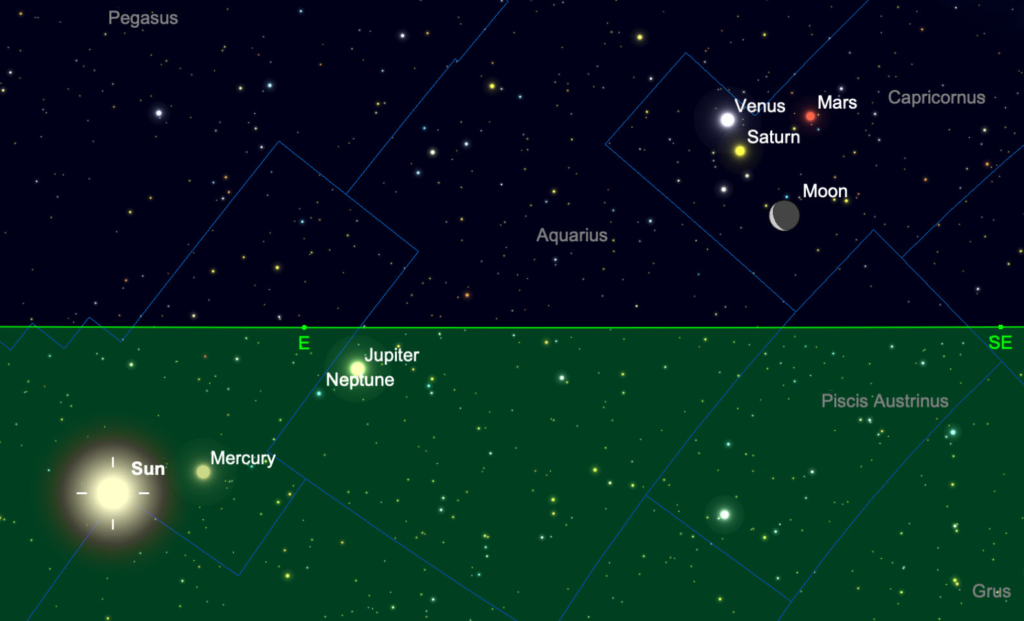Sky Report: March 21-27

The sky on Monday morning, March 28, 1 hour before sunrise. The horizon is made lucent so you can see through it to planets that have not yet risen. Thin blue lines are constellation boundaries. Graphic created with SkySafariAstronomy.com.
The planets are going through interesting motions in the morning sky that you don’t want to miss. This is the best week and it culminates on the morning of Monday the 28th, which is included here. Then things quiet down. The best time is roughly 45 minutes before sunrise but you have a wide window of time. It’s a photo op, especially with horizon features and the colors of the coming sunrise.
The first planet you’ll see is Venus, in the southeast. Venus is brilliant, and no other star begins to compare with it. It’s worth examining it for a few minutes to notice its pure light with lack of color, to see if it’s twinkling or not, and to discover if it casts a shadow, perhaps on a white piece of paper you provide. It’s quite the sight and worth spending some time with it. Recall that to some cultures it was a god.
Venus is a hundred million miles from earth, slightly farther than the sun, and through a small telescope it looks like a tiny half-moon.
As this week begins, Venus makes a compact triangle with two much fainter planets, but all three are easily visible. They are the Red Planet Mars to the right of Venus while Saturn is to the left of Venus but by weekend is basically below it. The triangle changes shape daily and becomes more compact, so watch each morning if you can. Venus is moving slowly to the west against the background stars while Saturn and Mars are moving to the east. On the 21st the triangle spans 10° from Saturn to Mars so only the widest-angle binoculars will show all three. On the 24th that distance is 7½° and on the 27th almost 6°. During this time Venus has moved from closer to Mars to closer to Saturn, as the triangle changes shape. This is a superb and rare chance to see three planets move against each other, so do not miss it.
But the best is yet to come, and although it officially happens next week I include it here as part of this series.
On the morning of Monday the 28th the moon joins the three planets in a wonderful compact grouping that is one of the best of the year. The moon is the thinnest of crescents only 16% illuminated by the sun and it’s directly below the planets, so it will not be far above your horizon. The widest binoculars will see all four, but in most binoculars you will see only three at a time.
All these are in the western end of Capricornus, the ancient Sea-Goat. As a friend said, every night is a new show. We have front row seats and admission is free.
Also noteworthy, the moon is near the red star Antares, the heart of the Scorpion, on the morning of the 23rd when they’re only 2° apart. And on the morning of the 25th it’s smack in the middle of Sagittarius.
Thanks to a 2021 grant from the Utah Governor’s Office of Economic Opportunity and the Kane County Office of Tourism, Stellar Vista Observatory offers portable telescopes and tripod mounted binocular kits on loan for free to all residents of Kane County. Nothing beats a quality binocular or astronomical telescope to enhance enjoyment of the night sky!
Visit https://stellarvistaobservatory.org/discover-the-night-sky/ or Kanab City Library for full details.
The Sky Report is presented as a public service by the Stellar Vista Observatory, a nonprofit organization based in Kanab, Utah, which provides opportunities for people to observe, appreciate, and comprehend our starry night sky. Additional information is at www.stellarvistaobservatory.org. Send questions and comments to John@StargazingAdventures.org.






Comments are closed.